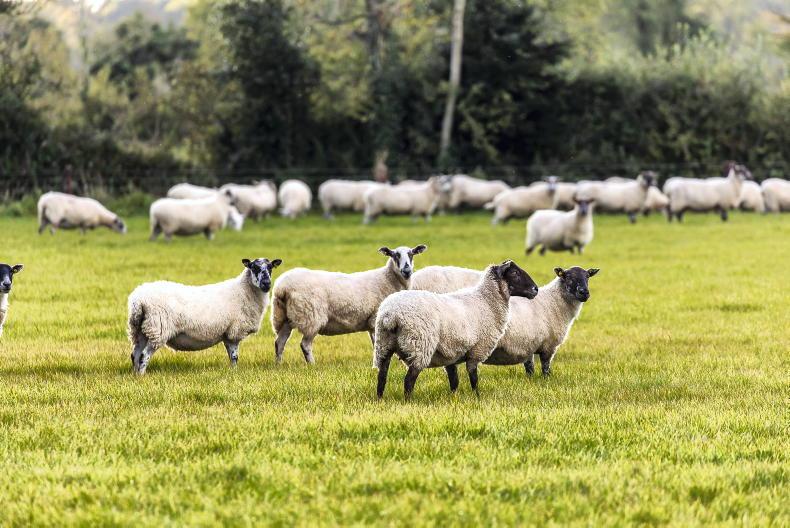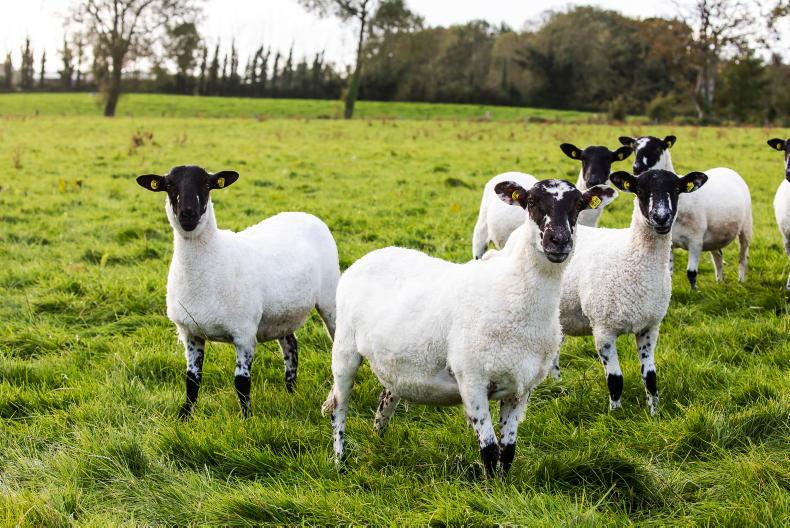The lamb drafting pattern is getting back on track on Tullamore Farm, with over 100 lambs drafted over the last month. Early weaning, followed by a sustained drought period, significantly hit performance earlier in the year, which in turn pushed out finishing dates and hampered the normal drafting pattern.
Lamb performance has improved markedly in recent weeks, in terms of daily performance and slaughter performance. Table 1 details the slaughter performance of lambs drafted to-date.
The last batch of 51 lambs included 33 ram lambs and 18 ewe lambs. The lambs, which were marketed through the Offaly Quality Lamb Producer Group and slaughtered in Irish Country Meats Camolin, achieved an average carcase weight of 20.63kg and sale price of €109.21.
Slaughter performance
The average kill-out achieved has increased steadily since the end of August and this is being driven by renewed lamb performance and also by the fact that lambs have received supplementation for longer. Farm manager Shaun Diver continues to excel in terms of lamb selection, with lambs drafted at the optimum fat cover and liveweight.
On the latter topic, the average slaughter performance hides significant variation between the group. The biggest challenge with ewe lambs is selecting lambs before they go overfat and succumb to significant price penalties. The lightest lamb in the most recent batch was a 40kg butty ewe lamb that killed 18.9kg carcase weight. The lamb had recorded a significant slowdown in performance over the last two weeks, and had reached her peak weight. The average kill-out of ewe lambs was recorded at over 46%, while the average liveweight at drafting was 43.56kg.
There is even more variability in the slaughter performance of ram lambs. The average drafting weight was 47.29kg, with an average kill-out percentage of just over 45%. Some strong ram lambs expressing a lot of Mule characteristics killed out as low as 40% to 42%, while better quality Texel x Mule lambs and younger Charollais x Texel cross lambs born to yearling hoggets achieved a kill-out of up to 48% to 50%. This reflects issues with poor kill-outs reported nationally and farmers should be mindful of this when making their own drafting decisions.
Drafting rate
The latest draft of lambs brings the overall drafting rate to 74%. This includes the 183 lambs drafted for slaughter, 40 Texel x Mule cross ewe lambs retained as replacements and 57 ewe lambs sold for breeding. The latter batch of ewe lambs was sold in early September at an average liveweight in the region of 40kg and an average sale price of €111.

Mature ewes have been transferred onto a better plane of nutrition and will be weighed and condition scored this week, along with allocationg groups for single sire mating. \ Philip Doyle
While the drafting rate is slightly behind target, it should be noted that a high percentage of the 100-odd lambs remaining are lambs born well into April and reared by yearling hoggets, as well as triplet-born lambs reared artificially. Shaun reports that a high percentage of these lambs are in the region of 37kg to 42kg and he expects a significant percentage to be drafted by the end of October.
Ram lambs are currently receiving 0.5kg concentrate supplementation at grass and this may be increased in the coming weeks if weather deteriorates and grass utilisation drops. Ewe lambs were receiving in the region of 0.25kg concentrates per head daily and this has recently been increased to 0.3kg. This level of supplementation will be monitored in line with performance.
Breeding preparations
It is now less than two weeks before the planned breeding date for mature ewes of 21 October. Ewes were used to clean off paddocks, but are now being offered access to better-quality grazing. Condition is being monitored closely and ewes were in the yard last week to receive a mineral drench and were also run through a footbath.

Replacement Mule ewe lambs, which were purchased in early September, have performed well in recent weeks and should be on course to hit target weights at breeding.\ Philip Doyle
They will be brought back to the yard again this week to be weighed and condition scored as part of the flock’s link up to the Sheep Ireland breeding programme. It will be interesting to see the performance of yearling hoggets and assess if breeding has had a significant effect on their liveweight. A full breakdown of weights and performance will be published, once available, in the weekly Tullamore Farm online update and summarised in print in the weeks ahead.
Ewes will also be allocated at random to breeding groups for single sire mating. Following the collection of data, ewes will be dipped in a mobile plunge dipping unit. There was a concern that yearling hoggets that reared lambs may have required treatment for worms, but a faecal egg count has shown there is no need.
The lamb drafting pattern is getting back on track on Tullamore Farm, with over 100 lambs drafted over the last month. Early weaning, followed by a sustained drought period, significantly hit performance earlier in the year, which in turn pushed out finishing dates and hampered the normal drafting pattern.
Lamb performance has improved markedly in recent weeks, in terms of daily performance and slaughter performance. Table 1 details the slaughter performance of lambs drafted to-date.
The last batch of 51 lambs included 33 ram lambs and 18 ewe lambs. The lambs, which were marketed through the Offaly Quality Lamb Producer Group and slaughtered in Irish Country Meats Camolin, achieved an average carcase weight of 20.63kg and sale price of €109.21.
Slaughter performance
The average kill-out achieved has increased steadily since the end of August and this is being driven by renewed lamb performance and also by the fact that lambs have received supplementation for longer. Farm manager Shaun Diver continues to excel in terms of lamb selection, with lambs drafted at the optimum fat cover and liveweight.
On the latter topic, the average slaughter performance hides significant variation between the group. The biggest challenge with ewe lambs is selecting lambs before they go overfat and succumb to significant price penalties. The lightest lamb in the most recent batch was a 40kg butty ewe lamb that killed 18.9kg carcase weight. The lamb had recorded a significant slowdown in performance over the last two weeks, and had reached her peak weight. The average kill-out of ewe lambs was recorded at over 46%, while the average liveweight at drafting was 43.56kg.
There is even more variability in the slaughter performance of ram lambs. The average drafting weight was 47.29kg, with an average kill-out percentage of just over 45%. Some strong ram lambs expressing a lot of Mule characteristics killed out as low as 40% to 42%, while better quality Texel x Mule lambs and younger Charollais x Texel cross lambs born to yearling hoggets achieved a kill-out of up to 48% to 50%. This reflects issues with poor kill-outs reported nationally and farmers should be mindful of this when making their own drafting decisions.
Drafting rate
The latest draft of lambs brings the overall drafting rate to 74%. This includes the 183 lambs drafted for slaughter, 40 Texel x Mule cross ewe lambs retained as replacements and 57 ewe lambs sold for breeding. The latter batch of ewe lambs was sold in early September at an average liveweight in the region of 40kg and an average sale price of €111.

Mature ewes have been transferred onto a better plane of nutrition and will be weighed and condition scored this week, along with allocationg groups for single sire mating. \ Philip Doyle
While the drafting rate is slightly behind target, it should be noted that a high percentage of the 100-odd lambs remaining are lambs born well into April and reared by yearling hoggets, as well as triplet-born lambs reared artificially. Shaun reports that a high percentage of these lambs are in the region of 37kg to 42kg and he expects a significant percentage to be drafted by the end of October.
Ram lambs are currently receiving 0.5kg concentrate supplementation at grass and this may be increased in the coming weeks if weather deteriorates and grass utilisation drops. Ewe lambs were receiving in the region of 0.25kg concentrates per head daily and this has recently been increased to 0.3kg. This level of supplementation will be monitored in line with performance.
Breeding preparations
It is now less than two weeks before the planned breeding date for mature ewes of 21 October. Ewes were used to clean off paddocks, but are now being offered access to better-quality grazing. Condition is being monitored closely and ewes were in the yard last week to receive a mineral drench and were also run through a footbath.

Replacement Mule ewe lambs, which were purchased in early September, have performed well in recent weeks and should be on course to hit target weights at breeding.\ Philip Doyle
They will be brought back to the yard again this week to be weighed and condition scored as part of the flock’s link up to the Sheep Ireland breeding programme. It will be interesting to see the performance of yearling hoggets and assess if breeding has had a significant effect on their liveweight. A full breakdown of weights and performance will be published, once available, in the weekly Tullamore Farm online update and summarised in print in the weeks ahead.
Ewes will also be allocated at random to breeding groups for single sire mating. Following the collection of data, ewes will be dipped in a mobile plunge dipping unit. There was a concern that yearling hoggets that reared lambs may have required treatment for worms, but a faecal egg count has shown there is no need.








 This is a subscriber-only article
This is a subscriber-only article









SHARING OPTIONS: